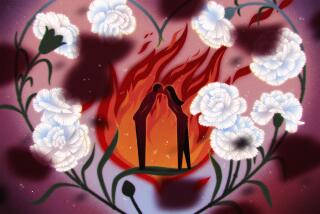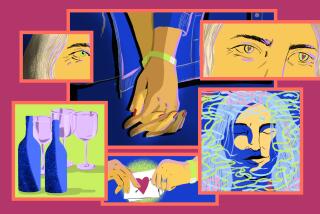Advice to ‘Women in Dilemma’: Man-Sharing
WASHINGTON — Six years go, Audrey Chapman, a therapist specializing in male-female relationships, asked a man she had been dating if she could park a suitcase in his apartment.
“He started hedging, giving me all these strange stories,” she remembers. Finally he said, ‘Look, I’ve had a friend here all weekend. It would just not be comfortable for you to do that, and I’m sorry.’ ”
It wasn’t her first encounter with man-sharing, but she was “shocked . . . frustrated and then angered. I should have known. But in those days I wasn’t picking up on a lot of man-speak.”
Now Chapman has a rule to drop a relationship with “anyone who starts out lying to you directly or indirectly.”
Years of listening to men and women discuss the hazards and advantages of non-exclusive relationships prompted Chapman to put her guidelines into a new book, “Mansharing: Dilemma or Choice?” For the past few months, Chapman has been calling for more openness about what used to be looked on as plain infidelity and hearing more and more women say man-sharing--both voluntary and involuntary--is a routine part of their lives.
“Unfortunately, I have been misunderstood. Many people believe I am suggesting people should share,” said Chapman during a break from the sexual front lines of the “Donahue” show and other forums. “In fact, I am telling women that if they don’t recognize the fact that they are sharing, they simply continue to set themselves up in helpless, powerless situations with men. My sole purpose for writing about man-sharing is to empower women to make effective decisions.”
Single Women Prefer
Chapman discovered through her work at the Howard University Counseling Service, her bi-monthly radio show and her coping workshops across the country that some single women prefer having multiple lovers, and others are committed to one man but want answers on how to deal with his other alliances.
“Most women define man-sharing as a relationship where they are being monogamous and where the man has a harem of women in the background,” Chapman said. “The newer notion is the single woman with several men.”
Women of the 1980s, she says, “are not only choosing several sexual partners” but see other men as well “to provide different aspects of friendship.” Despite all the emphasis on sexuality in recent years, she says, “a lot of people are finding non-sexual relationships to be a pleasure because there is no stress there, no pressure to perform.”
Though indiscretion and misunderstanding have marked couples forever, Chapman appears to have disturbed a rather curious sexual seismograph. “One woman said it was frightening for her to read the book because it reminded her of how vulnerable she would be,” the author says. Others have termed her “gutsy” to open herself up for criticism, she says.
That criticism has ranged from accusations that she is publicly advocating polygamy to charges that she is speeding the disintegration of the American family.
Chapman, 40, who was divorced seven years ago after her husband disclosed his sharing habits on their 10th anniversary, doesn’t look like a threat to family stability. She has a controlled, almost prim smile that gives her oval face the calmness of a portrait. In appearance as well as attitude, she looks very much the image of the career women described in her book, conservatively dressed in a designer navy suit with boxy shoulders and a silk print blouse.
So when she was called “the most dangerous woman in D.C,” Chapman was amused.
A few months ago, she said, she was dancing at a Washington disco and heard a woman nearby tell her partner, “That’s Audrey Chapman.”
“The gentleman with her said, ‘Oh, that woman, she is terrible! My girlfriend starting listening to her show. She started thinking about things that were going on. The next thing I knew she was aware of certain dynamics, beginning to question me, starting to be more assertive. Before I knew it we were having more conflicts. We ended up breaking up. I think she is the most dangerous woman in D.C.,’ ” Chapman recounts. “I said ‘Hello,’ and he said, ‘I don’t want to know you. I can’t imagine anyone wanting to have anything to do with you.’ And he left.”
Open Relationship
Other men, in not-so-fiery outpourings, have told her man-sharing is an individual interpretation. “Many of the men who were married did not believe they were really having affairs. If the affair went on beyond three months, then they would consider it serious if they also invested by taking her out. The single man defines sharing as an open relationship where the woman knows he sees other people and he knows she sees other people.”
Men, Chapman believes, are less likely to “confuse sexuality with emotions. They seem to be very comfortable in separating the two. Women start out saying they are very clear about (things) but somehow it gets emotional. We as women don’t take responsibility for our own sexuality. We attach love to it because that makes it more responsible.”
She chose the term “man-sharing” because she feels the phrase catches the temporary nature of the 1980s. “A lot of things are temporary; we have throwaway diapers, throwaway relationships. It’s all fast.”
Though some applaud her goal of helping women gain control of their lives, others feel she is, in effect, encouraging infidelity. She denies it, saying she’s just dealing with reality. “We lie in America about monogamy. We preach it, but we don’t practice it, on the whole,” she says.
‘We Are in Crisis’
Still others believe the behavior she has described only adds to the widely held belief that the family, especially the black family, is in serious trouble. “I have an investment in family life even though some people don’t believe it these days,” she says with an exasperated laugh. “In terms of drugs, teen-age pregnancy, teen-age suicide and alcoholism, we are in crisis in this country. In families where people are having affairs, you don’t have two people working in unity to help this teen-ager. . . . What I am hoping to do is help married women become more aware of signs that may indicate their marriages are in early stages of trouble.
“This problem doesn’t know color. Pain is colorless. Everybody experiences it the same way . . . to make a real strong point that this is a sexual issue, not a color issue. The only thing that is black is the author.”
In the research for the book and in the first phase of her book tour, Chapman found the man-sharing dilemma widespread and partly a response to the watershed changes toward sexuality in the past 20 years. “We were hit with a women’s movement that changed social ethics for women. Dovetailing with the women’s movement was the sexual revolution and new attitudes, with women wanting to be more assertive. With that women were initiating dates, who they would go out with, what the agenda would be for the evening. I think men decided, ‘This is not so bad. I don’t have to struggle; I don’t have to talk about commitment. It is real easy now.’ In fact, many of the men I talked to said women made it too easy.”
In the end, Chapman found, those who view today’s man-sharing as a problem are now looking back with some regrets on the liberation of the 1960s and 1970s. “It has led to people believing in sexual contact rather than emotional connections. We ended up in the late 1970s and early 1980s with people fearful of commitment, confused about what intimacy was. . . . We got lost somehow in all that so-called freedom.”
But a group of predominantly single women, called by Chapman “the new women of choice,” is enjoying latitude both in sex partners and friends. “They didn’t know anything about a male shortage. Many of them were divorcees, widows, or single-never-married, beyond the age of 35 or more. These women had love, had been married, where they believed initially in monogamy, a commitment, only to discover that from all practical points it didn’t work. They made some new decisions about how to take care of themselves in the social arena. They would define how their relationships would be; society would not. They manage . . . with a real sense of assurance.”
One Washington woman told Chapman it was “the pair-and-the-spare theory.”
Chapman laughs at that woman’s approach, but adds she has mixed feelings about the women of choice. “They tell me they didn’t create present conditions in America. They are products of it. They are doing what they feel they need to do to survive at the social level. They don’t see it as permanent; they don’t want the rest of their lives to be this way. But this is an immediate solution. They are not feeling helpless and in pain like the women in dilemma who are always in pain.
‘Who Are They Hurting?’
“Unlike the men who are involved with those women of dilemma, their men don’t experience guilt and frustration. Everyone knows what the real deal is. So when I look at the single women, I say, ‘Who are they hurting? What is wrong, except they are violating a social value that says women should be chaste?’ ”
Chapman grew up believing in “Mr. Right.” She was born in New Haven, Conn., the daughter of a teacher and a businessman who owned a janitorial service. She has a bachelor’s degree in child development from Goddard College, a master’s in counseling from the University of Bridgeport and is a doctoral candidate in clinical psychology at the Fielding Institute.
After several years of counseling, she moved to Washington in 1979 and joined the Institute of Urban Affairs and Research, and later moved to Howard’s counseling service. Three years ago she decided to “do something” about all the stories she had been hearing about man-sharing.
Her advice for women of choice and women in dilemma is to build relationships for different aspects of life. Some men should be regarded as short-term investments, and Chapman calls them “stopgaps and fill-ins.” Other men are strictly companions and are enlisted for various needs, such as an escort to a black-tie event. Another type is “the long-interval man, a friend and lover who moves in and out of a woman’s life, and the bond may be spiritual as well as historic. Others are and should be friends.”
For the woman who wants a monogamous relationship, Chapman says to watch for some standard signs that her man might be straying. She lists: “He fusses more with his physical appearance, maybe even changing his style of dress or brand of cologne”; “You notice a marked increase in hang-up calls and wrong numbers”; there are lots of absences; and “He moves farther and farther away from you in bed.”
When man-sharing is a choice, Chapman says, a woman needs a few rules to maintain her mental health. “Realize that there are always many options available to you”; or “Use power and control only over yourself. Your goal is self-control, not control of others.”
Her own expertise is reinforced by personal experiences. She says, “I haven’t missed any course of events that singles go through. From the meeting someone, falling feeling it would develop into a second marriage, and finding it would not, to casual dating, to periods where there has been no one.”


